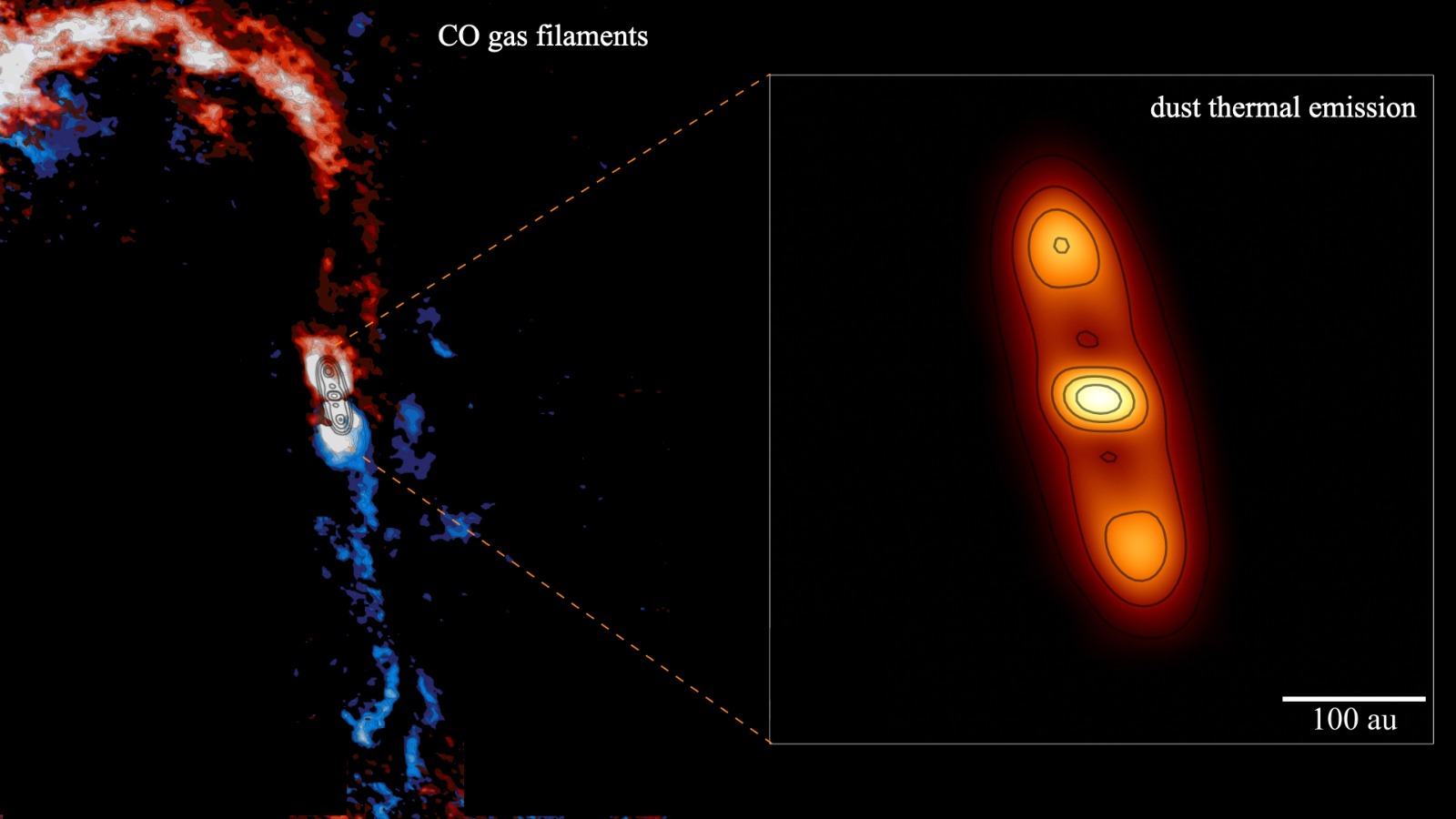Disk, planet and star of the same system seen growing together

The study has an important contribution from an Institute of Space Studies of Catalonia (IEEC) researcher at Institute of Space Science (ICE, CSIC)
Stellar systems, like our own, form inside interstellar clouds of gas and dust that collapse producing young stars surrounded by protoplanetary disks. For the first time, the Atacama Large Millimeter/submillimeter Array (ALMA) has observed a protoplanetary disk with a large gap being fed by the surrounding cloud via large accretion filaments, suggesting that a planet may be forming in tandem with the parent star while the disk around them is still growing.
The team of astronomers led by Dr. Felipe Alves, from the Center for Astrochemical Studies (CAS) at the Max Planck Institute for Extraterrestrial Physics (MPE) and former doctoral student at the Institute of Space Studies of Catalonia (IEEC — Institut d’Estudis Espacials de Catalunya), used ALMA to study the accretion process in the stellar object [BHB2007] 1. This system is located at the tip of the Pipe Molecular Cloud. The ALMA data reveal a disk of dust and gas around the protostar, and large filaments of gas around this disk.
The scientists, which include the researcher Josep Miquel Girart from IEEC at the Institute of Space Sciences (ICE, CSIC), interpret these filaments as accretion streamers feeding the disk with material extracted from the ambient cloud. The disk reprocesses the accreted material, delivering it to the protostar.

Caption: Two different observations of the protoplanetary disk. The left and central panel shows different signatures of the disk carved by a young planet or brown dwarf surrounding a young star. The right panel displays an illustration of the system.
Credits: MPE; illustration: Gabriel A. P. Franco.
The structure observed is very unusual for stellar objects at this stage of evolution — with an estimated age of 1,000,000 years — when circumstellar disks are already formed and matured for planet formation. “We were quite surprised to observe such prominent accretion filaments falling into the disk”, said Dr. Alves. “The accretion filament activity demonstrates that the disk is still growing while simultaneously nurturing the protostar.”
The team also reports the presence of an enormous cavity within the disk, suggesting a young giant planet or a brown dwarf being formed. The cavity has a width of 70 astronomical units, and it encompasses a compact zone of hot molecular gas. In addition, supplementary data at radio frequencies by the Very Large Array (VLA) point to the existence of non-thermal emission in the same spot where the hot gas was detected. These two lines of evidence indicate that an astronomical object is present within the cavity. As this stellar companion, possibly a planet, accretes material from the disk, it heats up the gas and possibly powers strong ionized winds and/or jets. The team estimates that an object with a mass between 4 and 70 Jupiter masses is needed to produce the observed gap in the disk.
These observations also put new time constraints for planet formation and disk evolution, shedding light on how stellar systems like our own are sculpted from the original cloud.
Links
More information
This research is presented in the paper “A case of simultaneous star and planet formation”, by Felipe O. Alves et al., published in The Astrophysical Journal Letters on 19 November 2020.
The Institute of Space Studies of Catalonia (IEEC — Institut d’Estudis Espacials de Catalunya) promotes and coordinates space research and technology development in Catalonia for the benefit of society. IEEC fosters collaborations both locally and worldwide and is an efficient agent of knowledge, innovation and technology transfer. As a result of over 20 years of high-quality research, done in collaboration with major international organisations, IEEC ranks among the best international research centers, focusing on areas such as: astrophysics, cosmology, planetary science, and Earth Observation. IEEC’s engineering division develops instrumentation for ground- and space-based projects, and has extensive experience in working with private or public organisations from the aerospace and other innovation sectors.
IEEC is a private non-profit foundation, governed by a Board of Trustees composed of Generalitat de Catalunya and four other institutions that each have a research unit, which together constitute the core of IEEC R&D activity: the University of Barcelona (UB) with the research unit ICCUB — Institute of Cosmos Sciences; the Autonomous University of Barcelona (UAB) with the research unit CERES — Center of Space Studies and Research; the Polytechnic University of Catalonia (UPC) with the research unit CTE — Research Group in Space Sciences and Technologies; the Spanish Research Council (CSIC) with the research unit ICE — Institute of Space Sciences. IEEC is integrated in the CERCA network (Centres de Recerca de Catalunya).
Images
Image: PR_Image1
Caption: False-colour image showing the filaments of accretion falling into the protoplanetary disk (seen in the inset) around the protostar [BHB2007] 1.
Credits: MPE.
Contacts
IEEC Communication Office
Barcelona, Spain
Ana Montaner and Rosa Rodríguez
E-mail: comunicacio@ieec.cat
Lead Researcher at IEEC
Barcelona, Spain
Josep Miquel Girart
Institute of Space Studies of Catalonia (IEEC)
Institute of Space Sciences (ICE, CSIC)
E-mail: girart@ieec.cat
